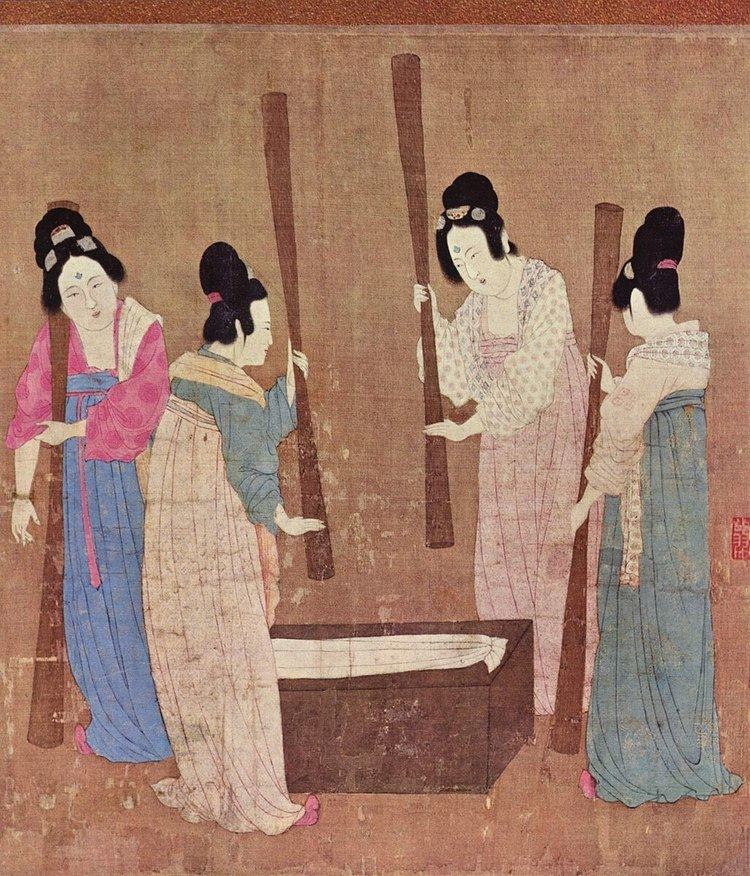 | ||
Sericulture, or silk farming, is the cultivation of silkworms to produce silk. Although there are several commercial species of silkworms, Bombyx mori (the caterpillar of the domesticated silk moth) is the most widely used and intensively studied silkworm. Silk was first produced in China as early as the Neolithic period. Sericulture has become an important cottage industry in countries such as Brazil, China, France, India, Italy, Japan, Korea, and Russia. Today, China and India are the two main producers, with more than 60% of the world's annual production.
Contents
History
According to Confucian text, the discovery of silk production dates to about 2700 BC, although archaeological records point to silk cultivation as early as the Yangshao period (5000 – 3000 BC). By about the first half of the 1st century AD it had reached ancient Khotan, by a series of interactions along the Silk Road. By 140 AD the practice had been established in India. In the 6th century the smuggling of silkworm eggs into the Byzantine Empire led to its establishment in the Mediterranean, remaining a monopoly in the Byzantine Empire for centuries (Byzantine silk). In 1147, during the Second Crusade, Roger II of Sicily (1095–1154) attacked Corinth and Thebes, two important centres of Byzantine silk production, capturing the weavers and their equipment and establishing his own silkworks in Palermo and Calabria, eventually spreading the industry to Western Europe.
Production
Silkworm larvae are fed with mulberry leaves, and, after the fourth moult, climb a twig placed near them and spin their silken cocoons. This process is achieved by the worm through a dense fluid secreted from its structural glands, resulting in the fiber of the cocoon. The silk is a continuous filament comprising fibroin protein, secreted from two salivary glands in the head of each larva, and a gum called sericin, which cements the filaments. The sericin is removed by placing the cocoons in hot water, which frees the silk filaments and readies them for reeling. This is known as the degumming process. The immersion in hot water also kills the silkworm pupae.
Single filaments are combined to form thread, which is drawn under tension through several guides and wound onto reels. The threads may be plied to form yarn. After drying, the raw silk is packed according to quality.
Stages of production
The stages of production are as follows:
- The silk moth lays thousands of eggs.
- The silk moth eggs hatch to form larvae or caterpillars, known as silkworms.
- The larvae feed on mulberry leaves.
- Having grown and moulted several times silkworm weaves a net to hold itself
- It swings its head from side to side in a figure '8' distributing the saliva that will form silk.
- The silk solidifies when it contacts the air.
- The silkworm spins approximately one mile of filament and completely encloses itself in a cocoon in about two or three days. The amount of usable quality silk in each cocoon is small. As a result, about 2500 silkworms are required to produce a pound of raw silk
- The intact cocoons are boiled, killing the silkworm pupae.
- The silk is obtained by brushing the undamaged cocoon to find the outside end of the filament.
- The silk filaments are then wound on a reel. One cocoon contains approximately 1,000 yards of silk filament. The silk at this stage is known as raw silk. One thread comprises up to 48 individual silk filaments.
Mahatma Gandhi was critical of silk production based on the Ahimsa philosophy "not to hurt any living thing". He also promoted 'Ahimsa silk', made without boiling the pupae to procure the silk and wild silk made from the cocoons of wild and semi-wild silk moths. In the early 21st century the organisation PETA has campaigned against silk.
